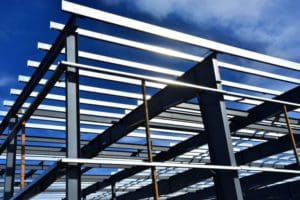
Steeling the Spotlight: How Steel Buildings Champion Eco-Friendly Construction
In a world that’s constantly evolving, it’s no surprise that the construction industry is undergoing its own transformation. Among the plethora of building materials available today, steel stands tall as a front-runner in eco-friendly solutions. Here’s a closer look at why steel buildings are being hailed as champions of sustainable construction.
Recyclability at Its Best
Steel is one of the most recyclable materials on the planet. In fact, modern steel is made of approximately 88% recycled product. Once a steel building has served its purpose and reaches the end of its lifecycle, almost every part can be recycled and used again. This circular approach means fewer resources are extracted from the Earth, leading to reduced environmental strain.
Energy Efficiency
Steel buildings are often more energy-efficient than their brick, wood, or concrete counterparts. With the right insulation, a steel building can retain heat during the winters and reflect heat during the summer months. This not only ensures a comfortable environment within but also leads to substantial energy savings.
Sustainability in Production
Steel production has seen remarkable innovations over the years. Today’s processes are more energy-efficient and produce fewer carbon emissions than ever before. Advanced technologies have enabled manufacturers to use less water, reduce waste, and lower energy consumption, making the production phase of steel much greener.
Durability and Longevity
One of the main environmental benefits of steel buildings is their longevity. Steel is resistant to many of the issues that can plague other materials, such as pests, mold, and rot. Moreover, it can withstand extreme conditions, from heavy snow to high winds. This durability means steel structures often require less maintenance and can stand for decades, if not centuries, reducing the need for new materials and the energy required for rebuilding.




Flexibility in Design
The malleability of steel allows for innovative architectural designs. This flexibility ensures that steel can be used to its maximum potential, reducing waste. As a bonus, steel buildings can be easily expanded, adapted, or reconfigured without extensive renovations or new materials.
The Lighter Side of Steel
Steel structures are often lighter than those made from concrete or wood, leading to a reduced foundation requirement. This results in less land disruption, fewer materials, and reduced energy consumption during the construction phase.
As the world shifts towards more sustainable practices, steel buildings are emerging as an ideal solution for eco-conscious individuals and businesses. From production to demolition, steel’s eco-friendly attributes shine, offering a blueprint for the future of green construction.
The Benefits of Investing in Steel Buildings
- Cost-Efficiency from Start to Finish: Steel buildings, especially those that are pre-engineered, provide a more cost-effective route than traditional construction methods. These structures come with precision-cut parts, reducing waste and avoiding unexpected costs. Furthermore, with components designed to fit together seamlessly, construction times are shortened, leading to savings on labor.
- Swift and Seamless Construction: The prefabricated nature of steel structures translates into rapid erection times. With components manufactured to fit perfectly, the need for adjustments on-site is minimized, allowing projects to move forward without unnecessary delays.
- Minimal Maintenance, Maximum Durability: Steel stands strong against many common foes of traditional construction materials. It resists rust, corrosion, pests, and decay, resulting in diminished maintenance costs over its lifetime. When you opt for steel, you’re choosing a building material that’s built to last.
- Adapt and Expand with Ease: Steel buildings are the epitome of versatility. They cater to a wide range of functions, from storage warehouses to stylish urban lofts. Additionally, should the need arise for more space, steel structures can be easily expanded, ensuring your building evolves with your needs.
- Unparalleled Interior Flexibility: Owing to the strength of steel, these buildings don’t require the support of bulky beams or walls, offering owners the luxury of an open floor plan. This design freedom is especially beneficial for commercial enterprises that demand adaptable spaces.
- Safety is Paramount: Steel’s non-combustible nature grants it a superior stance against fires, especially when compared to wood-based structures. Moreover, steel buildings are engineered to withstand the rigors of natural calamities, be it earthquakes, hurricanes, or heavy snow.
- A Green Building Solution: Steel’s recyclability means it can be repurposed multiple times without losing its strength. This, combined with energy-efficient construction possibilities, such as effective insulation, positions steel buildings as a frontrunner in sustainable construction. Additionally, the continual improvements in steel production processes mean that the industry’s carbon footprint is shrinking, making it an even greener choice.
When you choose steel as your building material, you’re aligning with a future-oriented approach. An approach that harmonizes cost-effectiveness with sustainability, safety, and adaptability, making steel buildings a judicious choice for the informed investor.



Comparing Steel Buildings to Traditional Construction
- Efficient Material Utilization
Steel buildings, predominantly those of the pre-engineered variety, optimize material usage. Every component is precision-designed and manufactured to specific dimensions, reducing wastage. In contrast, traditional construction often leads to surplus materials which may end up in landfills.
- Speed of Construction
Pre-fabricated steel parts mean that a building can be erected much faster than one using conventional methods. Faster construction not only reduces labor costs but also lessens the duration of environmental disruption on the construction site.
- Durability and Longevity
While traditional construction materials like wood can deteriorate over time due to elements or pests, steel’s resistance to these threats ensures a longer building lifespan. A long-lasting structure equates to fewer resources expended on repairs and replacements, underscoring an eco-friendlier approach.
- Recyclability
One of steel’s standout qualities is its recyclability. Once a steel building reaches the end of its life, almost every part can be recycled and reused. Traditional construction materials, on the other hand, often have limited recyclability, making steel the clear winner in the eco-friendly category.
- Energy Efficiency Potential
Modern steel buildings can be equipped with advanced insulation and energy-efficient features, reducing the building’s energy consumption. In contrast, some traditional construction methods might not offer the same level of energy efficiency, leading to increased energy use over the building’s lifespan.
- Lower Carbon Footprint in Production
Innovations in steel production have significantly reduced its carbon footprint over the years. Steel production now uses less energy and emits fewer greenhouse gases than before. On the other hand, producing and processing some traditional building materials can have a more considerable environmental impact.
By closely examining the advantages steel buildings hold over traditional construction methods, it becomes evident that they are not only economically viable but also environmentally responsible choices. With the pressing need for sustainable solutions in the modern age, the shift towards steel constructions signifies a step in the right direction.




How Much Do Steel Buildings Cost?
Cost of Materials
Steel buildings primarily derive their cost from the raw material, which is steel itself. As of recent data, the price of steel can vary widely based on global market conditions, but on average, it can range anywhere from $700 to $2,500 per ton. However, for steel buildings, one must also consider the costs associated with bolts, fittings, and other necessary components. This can bring the total material cost for a basic steel building to between $7 to $25 per square foot. Keep in mind that prices can fluctuate based on steel demand, tariffs, and other economic factors.
Cost by Size
The overall cost of a steel building also depends largely on its size. Here’s a general breakdown:
- Small Steel Buildings (less than 1,500 sq.ft.): Typically range from $7,500 to $15,000. These are ideal for single-car garages, small storage units, or workshops.
- Medium-sized Steel Buildings (between 1,500 to 5,000 sq.ft.): These can set you back anywhere from $20,000 to $70,000. Examples of such buildings are multi-car garages, large storage facilities, or small retail establishments.
- Large Steel Buildings (more than 5,000 sq.ft.): The price for these can start from $80,000 and go upwards, depending on the complexity and customization. These structures are often used for commercial purposes, aircraft hangars, or large-scale workshops.
Additional Costs
It’s essential to remember that the figures mentioned above are ballpark estimates for the structure alone. Several additional costs can influence the final price tag:
- Foundation and Groundwork: Depending on the soil quality, slope, and other factors, preparing the site and laying a foundation can add anywhere from $4 to $20 per square foot to the total cost.
- Labor Costs: While steel buildings are quicker to erect than traditional structures, labor still constitutes a significant expense, typically ranging from $3 to $10 per square foot.
- Insulation: If you’re planning to insulate your steel building, factor in an extra $1 to $3 per square foot.
- Customization and Add-ons: Features like custom doors, windows, ventilation systems, or specific architectural designs can influence the final cost. Depending on the customizations, you might add 10% to 20% more to the base price.




When contemplating a steel building, it’s essential to obtain multiple quotes, consider all factors, and remember that while the upfront cost may sometimes be higher than traditional construction, the durability, reduced maintenance, and eco-friendly nature of steel buildings often lead to savings in the long run.
Environmental Impact of Steel Buildings:
When considering sustainable construction methods, steel buildings emerge as a prime choice due to their minimal environmental impact. Here’s a closer look into how steel structures are contributing to a greener planet.
Reduced Carbon Footprint:
One of the major benefits of steel buildings over traditional construction methods is their significantly reduced carbon footprint. Conventional buildings, especially those utilizing wood or bricks, can have extensive energy costs associated with the extraction, transportation, and fabrication of their materials. On the other hand, steel production has seen considerable advances in recent years, resulting in more energy-efficient processes. Furthermore, the transportation and assembly of pre-engineered steel parts are less energy-intensive than traditional methods, resulting in fewer greenhouse gas emissions.
Recyclability of Steel:
Steel’s ability to be recycled is a game-changer in the realm of sustainable construction. Once a steel building has served its purpose or if any spare parts are left post-construction, the material doesn’t need to end up in a landfill. Instead, steel can be completely recycled. This inherent recyclability ensures that the demand for newly extracted raw material is reduced. Additionally, the process of recycling steel requires substantially less energy than producing new steel, thereby conserving energy and further reducing the carbon footprint of steel production.
Energy Efficiency:
Beyond just the production and recyclability advantages, steel buildings also offer superior energy efficiency when in use. The design of steel structures allows for effective insulation, ensuring that the indoor environment remains temperate, and reducing the need for heating or cooling. Proper insulation, coupled with the reflective properties of steel, can lead to substantial energy savings. This not only reduces the building’s environmental impact but also translates to significant cost savings for occupants in terms of reduced energy bills.
When evaluating the environmental benefits, steel buildings provide a compelling argument. From their carbon footprint to recyclability and energy efficiency, they stand as an eco-friendly alternative in the world of construction.



Maintenance and Durability
The longevity and minimal maintenance requirements of steel buildings are some of their most significant advantages. Their inherent properties give them an edge over traditional construction materials, leading to long-term savings and reduced environmental impacts. Here’s an in-depth look at the maintenance and durability aspects of steel structures.
Resistance to Common Issues:
Steel buildings come with an innate resistance to some of the most common problems faced by structures made from other materials. For instance:
- Termites: Unlike wooden structures, which are susceptible to termite infestations, steel provides no organic material for these pests to feed on. This means homeowners and business owners won’t have to worry about the structural damage or the costs associated with termite treatments.
- Rot: Steel doesn’t degrade in the same manner as organic materials like wood. It won’t rot or break down over time due to natural processes, ensuring a sturdy structure for longer periods.
- Mold: Steel surfaces are non-porous, which means they don’t retain moisture. Without a moist environment, mold, which can cause health issues and structural damage, has a hard time growing on steel.
Longevity and Minimal Maintenance:
Steel structures are synonymous with durability. With proper care, these buildings can last for several decades. The maintenance required for steel buildings is often minimal, especially when compared to materials like wood, which may require regular treatments to prevent rot or pest infestation. Paint or coatings on steel structures might need occasional touch-ups to counteract any potential rust, but such requirements are generally infrequent.
Withstanding Harsh Weather:
Another remarkable feature of steel buildings is their ability to stand strong in the face of challenging weather conditions. Here are some reasons why:
- Snow: The strength and flexibility of steel allow it to support heavy snow loads without the risk of structural damage. Its smooth surface also promotes the sliding off of snow, preventing excessive accumulation.
- Hurricanes and Storms: Steel buildings are engineered to withstand high wind speeds. Their tight connections and rigid frames mean they can resist the powerful forces of hurricanes, making them particularly useful in regions prone to such weather events.
- Temperature Fluctuations: Steel can endure extreme temperature changes, from sweltering heat to freezing cold, without its structural integrity being compromised.
Steel buildings, due to their maintenance benefits and enduring nature, not only provide a cost-effective solution but also reduce environmental strain by decreasing the frequency of replacements or extensive repairs. Investing in a steel structure is a choice that stands the test of time and elements.




Unleashing Customization and Design Flexibility in Steel Buildings
Steel buildings are not just about durability and sustainability; they also present a canvas for creativity and adaptability. Modern advances in steel fabrication and design methodologies have paved the way for buildings that are not only functional but also aesthetically pleasing and customizable to individual needs.
Immense Flexibility in Design
One of the standout features of steel buildings is their flexibility in design. Here’s why:
- Easy Expansion and Modification: Steel buildings can be designed in a modular fashion, allowing for effortless expansion or modification in the future. If a business grows and needs additional space, sections can be added to the existing structure without major disruptions or massive costs. For homeowners, this means the ability to add rooms or extensions as family needs change.
- Open Floor Plans: Without the need for load-bearing walls, steel structures can offer vast open spaces, ideal for warehouses, aircraft hangers, or even open-concept homes. This feature provides an unobstructed internal area, allowing users to utilize space as per their requirements.
Aesthetic Finishes for a Modern Look
Gone are the days when steel buildings were mere functional gray boxes. Today, they can be made to resemble almost any traditional structure, thanks to the myriad of finishes available:
- Cladding Options: From brick to wood, various cladding materials can be used to cover steel, giving it the appearance of conventional buildings. This ensures that steel buildings can blend seamlessly into any environment, be it a residential neighborhood or a business district.
- Color Choices: Modern coatings and treatments allow steel buildings to be finished in almost any color, catering to personal tastes and branding requirements.
- Architectural Details: Elements such as eaves, trims, and facades can be added to steel buildings to enhance their visual appeal and make them indistinguishable from traditional construction.
Unique Architectural Designs
Modern engineering techniques have enabled architects and designers to push the boundaries of what’s possible with steel:
- Innovative Forms: Steel’s strength-to-weight ratio allows for designs that might be challenging with other materials. Think cantilevered sections, intricate lattices, or sweeping curves.
- Sustainability Meets Design: Many contemporary designs incorporate eco-friendly features like green roofs, solar panel integrations, or large glazed areas for natural lighting, all of which can be seamlessly incorporated into steel buildings.
- Meeting Diverse Needs: Whether it’s a multi-story office complex, a bespoke home, or a quirky retail space, steel offers the flexibility to cater to a wide array of design briefs.
Steel buildings are at the forefront of modern construction, offering a blend of functionality, durability, and design prowess. Their adaptability ensures they’re fit for myriad purposes, from pragmatic industrial uses to avant-garde architectural marvels.




Safety Aspects of Steel Buildings
Safety is paramount in any construction project, and steel buildings, with their myriad of inherent protective qualities, set a high bar in this domain. Let’s delve deeper into the safety features that steel buildings offer, from fire resistance to seismic strength.
Fire Resistance of Steel
Steel’s non-combustible nature is one of its most lauded safety features. Unlike wood, which can act as fuel in the event of a fire, steel does not contribute to the spread of flames. This attribute provides several advantages:
- Potential Insurance Savings: Due to their fire-resistant nature, steel buildings might be viewed as lower-risk assets by insurance companies. This can lead to reduced insurance premiums, making steel structures not only safer but also more economical in the long run.
- Protection of Assets: A slower spread of fire means more time for occupants to evacuate and for emergency services to react. Moreover, businesses can have greater peace of mind, knowing that their valuable assets have an added layer of protection against fire damage.




Strength and Flexibility during Seismic Events
Earthquakes are unpredictable and can be devastating. However, steel buildings have attributes that make them particularly resilient during such events:
- Ductility: Steel can bend without breaking. This ductility means that during an earthquake, a steel structure can sway with the motion of the ground, reducing the likelihood of structural failure.
- Uniform Material: Unlike concrete or other composite materials, steel is homogenous, ensuring consistent strength throughout the structure, reducing weak points that might be susceptible to seismic forces.
- Lightweight: Steel’s high strength-to-weight ratio means that steel buildings are relatively lighter than those made from concrete. Lighter buildings tend to perform better during earthquakes, as they are subjected to lesser inertial forces.
Healthier Indoor Environments
While safety often conjures images of protection against catastrophic events, it also pertains to daily health and well-being. Steel buildings offer advantages here as well:
- Reduced Risk of Mold and Mildew: Steel is inorganic, meaning it doesn’t foster the growth of mold or mildew. Both of these fungi can be detrimental to health, causing respiratory issues and allergies. By reducing the potential for mold growth, steel buildings promote a healthier indoor environment.
- Minimal Off-gassing: Unlike some construction materials that might release harmful chemicals over time, steel is inert. This means occupants aren’t exposed to potentially harmful off-gassed chemicals, ensuring a purer indoor air quality.
Steel buildings don’t just stand tall and look impressive; they offer a robust shield against a range of threats, from raging infernos to shaking grounds, all while fostering a healthier living and working environment. This makes them an optimal choice for those prioritizing safety and well-being.
